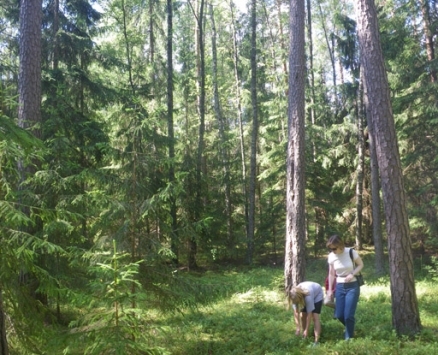Ecoregions of Lithuania.
Contents
Ecoregions of Lithuania
The ecoregions of Lithuania consist chiefly of two main forest types: Sarmatic mixed forests and Central European mixed forests. Smaller areas of specialty plant communities can also be found within Lithuania including peat bog conifer forests and coastal grasslands.
Sarmatic mixed forests
The Sarmatic mixed forests occupy portions of northern Lithuania, continuting north into Latvia and extending west to Scandinavia and east to the Ural Mountains; therefore, these forests occupy one of the widest longitudinal geometries of any ecoregion in the world. In addition to the dominant canopy Scots pine and Norway spruce intermixed with some broadleaf species, there are a number of shrubs, wildflowers, grasses and mosses that inhabit the mid-tier and forest floor. Common low growing shrubs include Bilberry (Vaccinium myrtillus) and Heather (Calluna vulgaris).
Example wildflowers or forbs seen in the forest understory include Common Spotted Orchid (Dactylorhiza fuchsii), Red Campion (Silene dioica), White Campion (Silene latifolia ssp. alba), Sand Catchfly (Silene conica), Field Scabious (Knautia arvensis) and Marsh Helleborine (Epipactis palustris). In some fens within forest clearings the Marsh thistle (Cirsium palustre) is found.
Widespread ferns seen on forest floors include Western Brackenfern (Pteridium aquilinum) and Mountain Bladderfern (Cystopteris montana). Common mosses found in the more mesic soils are Broom Forkmoss (Dicranum scoparium), Stairstep Moss (Hylocomium splendens), Red-stemmed Feathermoss (Pleurozium schreberi), Ostrich Plume (Ptilium crista-castrensis) and Common Hair Moss (Polytrichum commune).
Central European mixed forests
The Central European mixed forests constitute a portion of the Lithuanian landscape, and continue into portions of Poland, Belarus, Ukraine, the Czech Republic and Romania (Ecoregions of Romania). They consist of lowland to submontane acidophilous oak and mixed oak forests, mixed oak-hornbeam forests, as well as lowland to submontane hemiboreal and nemoral pine forests on the North European glaciated plain. It is bordered by the lowland-colline subcontinental meadow steppes and dry grassland vegetation on the eastern side, hemiboreal spruce and pine-spruce forests to the north, beech and mixed beech forests of the Carpathians to the south, and the beech and mixed beech forests of the Baltic and Western Europe to the west.
The ecoregion consists of vast plains in the middle, hilly moraines with lakes in the north, and upland areas in the south. The highest elevation within the region does not exceed 600 meters (m), and most of the area lies between 100 and 300 m above sea level. Mean annual temperatures are quite uniform throughout the region and range between seven and nine degrees Celcius (C); the climate is more mild in the west and more continental in the east. The mean January temperatures range from -1°C in Germany to -6°C in Belarus. Annual precipitation is between 500 and 700 millimeters (mm); most of which falls during the growing season, with maximum rainfall in July. Snow cover in the NE part of the region lasts over three months, but the accumulation of snow is not very high; in the south and in the west of the region snow cover in winter is ephemeral.
General Definition
Ecoregions are areas that: [1] share a large majority of their species and ecological dynamics; [2] share similar environmental conditions; and, [3] interact ecologically in ways that are critical for their long-term persistence. Scientists at the World Wildlife Fund (WWF), have established a classification system that divides the world in 867 terrestrial ecoregions, 426 freshwater ecoregions and 229 marine ecoregions that reflect the distribution of a broad range of fauna and flora across the entire Earth.
References
- Udo Bohn, Gisela Gollub, and Christoph Hettwer. 2000. Reduced general map of the natural vegetation of Europe. 1:10 million. Bonn-Bad Godesberg
- C.Michael Hogan. 2009. Marsh Thistle: Cirsium palustre. GlobalTwitcher.com, ed. N.Strömberg
- H.Sjors. 1999. Swedish plant geography: The background: Geology, climate and zonation. Acta Phytogeogr. Suec. Uppsala: Opulus press, 84:5-14.
- S.F.Kurnaev. 1973. Forest regionalization of the USSR. Nauka, Moscow Russian
- World Wildlife Fund. 2001. Sarmatic mixed forests. (PA0436)
